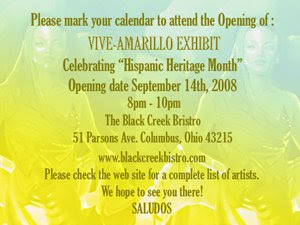Dia de los Muertos Presented by Latino Arts for Humanity
November 2008, The CAP at Union Station.

En este mundo matraca
De morir nadie se escapa.
Muere el buey, muere la vaca,
Y hasta la mujer más guapa tiene que estirar la pata.
Viene la muerte luciendo
mil llamativos colores
ven, dame un beso, pelona
que ando huérfano de amores.
Se va la muerte cantando
por entre la nopalera,
¿En que quedamos, pelona,
me llevas o no me llevas?...
De morir nadie se escapa.
Muere el buey, muere la vaca,
Y hasta la mujer más guapa tiene que estirar la pata.
Viene la muerte luciendo
mil llamativos colores
ven, dame un beso, pelona
que ando huérfano de amores.
Se va la muerte cantando
por entre la nopalera,
¿En que quedamos, pelona,
me llevas o no me llevas?...
 Day of Death is a holiday with a complex history. Therefore It is important to explain and share our knowledge with others, to celebrate and understand it better.
Day of Death is a holiday with a complex history. Therefore It is important to explain and share our knowledge with others, to celebrate and understand it better. We would like to thank Rodolfo Vazquez
We would like to thank Rodolfo Vazquez
Making a mixture of the Prehispanic cults and the Christian religion, Mexicans say the death is not the natural end of the life; it is the process of an infinite cycle. Life, death and resurrection are the stadiums of the process in the Christian religion, in accordance with the Prehispanic concept of the death, the sacrifice of the death- the act of die- is the consent to accept the process creator that gives us the life. The body dies and the spirit is given to the Gods. But the Christianity modifies the sacrifice of the death. The death and the salvation become an individual process, for the Christians the person is the one who count. The beliefs unite again as soon as the life is only justified and transcends in the sacrifice of death.
 In Mexico more than a Christian festivity it is a celebration where we mix so much the pre-Hispanic culture as the catholic religion, where the Mexican town managed to maintain its old traditions alive.
In Mexico more than a Christian festivity it is a celebration where we mix so much the pre-Hispanic culture as the catholic religion, where the Mexican town managed to maintain its old traditions alive.
The celebration of the Day of the Dead is linked to the Agricultural calendar from the Prehispanic ancient; because this is the celebration when they started the harvest, Mexicans also thank the earth for their food and start a time to allow the earth to rest during winter.
Many thanks to:
Nancy Pyon, Guadalaupe Velasquez, Angela Morales, Elizabeth,Patrick Smith, Chad Chadwick, Rodolfo Vazquez, La Oaxaquena store and Fronteras de la Noticia for their support to help me set the exhibit and for believe in the festivity and tradition of the Day of the dead.
Leticia Vazquez.









